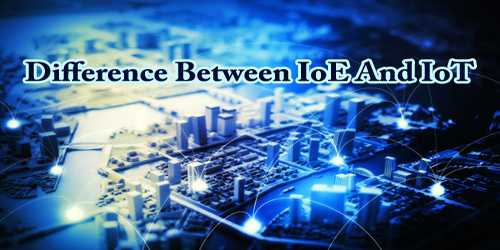The core difference between the Internet of Things (IoT) and the Internet of Everything (IoE) are given bellow:
Internet of Things (IoT) –
- The term IoT was coined in 1999 to refer to machine-to-machine, or M2M (machine-to-machine), communication.
- IoT is a computer term that describes the future of linking ordinary physical objects to the Internet and being able to link themselves with other devices.
- IoT brings to access to the real world of physical objects from the internet, data analysis and analytics, and decision-taking.
- The IoT, in essence, is the inter-connectivity of physical objects that send and receive data.
- The goal of IoT is to form an ecosystem of connected objects/physical devices. Or to create an ecosystem connecting from Thing to Thing.
- It is less complex than IoE because it is considered because part of the Bigger IoE ecosystem by IoT (Internet of Things)
- Internet of Things ( IoT) is the manufacture (+ programming + configuration) of the everyday use of electronic products, such as the refrigerator, clothes, washing machine, television, etc., in such a way that they can be regulated through the Internet.
- The idea of the Internet of Things (IoT) has gained popularity because of its ability to connect unconnected physical-first objects that were previously unable to produce, distribute and receive data unless they have been modified or manipulated.
- IoT provides as a building block for the internet of everything.
- Examples are Wearable health monitors, connected appliances, Autonomous farming equipment, smarter energy management systems, and Smart surveillance.
Internet of Everything (IoE) –
- The concept of the Internet of Things (IoT) has gained popularity due to its ability to connect unconnected physical-first objects which were previously unable to create, transmit, and receive data unless changed or controlled by them.
- IoE is a systematic relationship between data, things, processes, and people. This allows the unification between previously separated physical and digital worlds.
- IoE encompasses the wider communication framework where network knowledge serves as the backbone of the Internet of Things (IoT).
- The IoE is a wider concept that involves various technologies and people as end-nodes, apart from IoT.
- IoE’s aim is to transform knowledge into practice, provide data-based decision-taking, and offer new technologies and richer experiences.
- It is more complex than IoT as IoE includes IoD (Internet of Digital), IoH (Internet of Human), and IoT (Internet of Things).
- Internet of Everything (IoE) is the branding of Cisco products which keeps IoT at its core.
- The Internet of Everything (IoE) concept originated as a natural evolution of the IoT revolution and is primarily aligned with Cisco’s strategy to introduce a new marketing domain; IoE incorporates the wider definition of networking from the viewpoint of the use-cases of digital communication technology.
- IoE will replace the Internet of Things as more and more devices will be connected and integrated with smart hardware such as sensors, and software, including machine learning and artificial intelligence.
- Examples are Connecting roads with hospitals to save more lives, Connecting homes for comfort living, Connecting food and people in the supply chain, Elderly care monitoring.
The Internet of Things (IoT) or The M2M Proposal opens up a wide array of possibilities for operators, developers, and customers. Yet IoE’s (Internet of Everything) Internet is so much larger than M2M.
Information Sources:
















